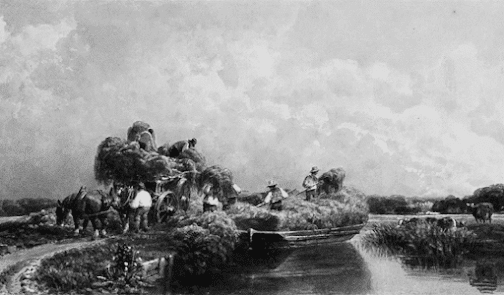The Fossdyke Canal
The canal connects Torksey and the River Trent to Lincoln’s Brayford, which was once a Roman port.
It should be more correctly described as a ‘canalised river’, as it is fed by the River Till, which flows into it at Odder.
The name is Roman, ‘Foss’ being Latin for a ditch, dyke, or trench.
Some historians consider it to be Roman, built around AD120.
Evidence for this is the site of a Roman pottery kiln at Little London close to the canal.
Additionally, a bronze statuette of the Roman God Mars (now in the British Museum) and a Roman sepulchral tablet were found in the canal during dredging in 1774.
The first documentary evidence we have of the canal is in 1121, when King Henry I made the Bishop of Lincoln responsible for clearing it. A monk, Simeon of Durham, wrote – ‘In the same year, King Henry cut a large canal from Torksey to Lincoln, and by causing the River Trent to flow into it, he made it navigable for vessels.’
Throughout the Middle Ages, there were complaints of the canal silting up. There were petitions to the Crown in 1299 and 1335.
Whilst Bishop of Lincoln in 1518, Cardinal Wolsey was influential in the re-opening of the canal.
 |
| 'A Roman Canal' by Peter de Wint 1840 |
By 1630 the canal had again fallen into disrepair.
John Taylor, known as the ‘Water Poet’, wrote ‘It is a passage cut through the land eight miles from Lincoln into the Trent, but through either the people’s poverty or negligence, it is grown up with weeds and mud, so that in the summer it is in most places almost dry.’
He described his trip from Lincoln to Torksey along the Foss in a book of poems entitled ‘A Very Merrie Wherry Ferry Voyage’.
From thence we past a ditch of weeds and mud,
Which they do (falsely) there call Forcedike Flood.
For I’ll be sworn, no flood I could find there,
But dirt and filth, which scarce my boat would bear.
The canal was Crown property until 1671, when on a visit to Lincoln, King James I gave it to Lincoln Corporation. This was perhaps a rather dubious gift, as it needed considerable repair. His Act allowed the City to charge tolls on ‘pit coals, sea coals, lead, corn, timber, wool, and other things’.
A lock was built at Torksey in 1672, although previously there had been what is described as ‘sluices’.
They approached Richard Ellison of Thorne, who was already leasing the River Don Navigation, and had served that Company as a surveyor.
After much hesitation, Ellison offered to take a 50% interest in the Fossdyke or to lease the whole for £75 per year.
The Corporation chose the latter option and granted a 999-year lease.
The lease was last sold in 2003; the canal is now rented by the leaseholders to the Canal and River Trust.
Ellison undertook to improve the navigation so that boats drawing 3ft 6in could pass at all seasons. Several fords still in use were converted to ferries; Hardwick and Skellingthorpe for example.
 |
| Skellingthorpe Ferry |
This was replaced by a swing bridge in 1823, which remained in use until the main road bridge was built in 1937. The swing bridge abutments can be seen beneath the footbridge.
The importance of the canal to Lincoln can be summarised in this description of the Brayford in 1810 – ‘To this place the inhabitants of the villages bring their production to market, in schuyts, or small boats, and take back their various purchases in the same way. The continual bustling of porters and watermen, the creaking of carts, the rolling of drays, the lowering and raising of masts, and the bawling and not very decent language of the sailors, render the waterside, if not one of the most delightful, at least one of the most noisy parts of the City’.
The canal continued in use as a commercial waterway until 1976.
I’ll have a look in more detail at the rather complicated who owns what on Saxilby Waterfront and the history surrounding it next month.
Chris Hewis






Comments
Post a Comment